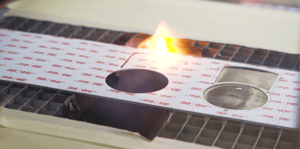Is laser die cutting the best way to build a gasket?
Laser cut gaskets can perform intricate functions with tight tolerances, yet there are also disadvantages to every gasket-making method.
Strouse has been manufacturing die cut gaskets for over three decades, so we’ve had the time to explore different production options for time, cost, and quality optimization. The result? While some projects may benefit from laser cutting, others are better suited to alternative manufacturing methods.
If you’re interested in using laser cut gaskets, read on to fully understand the unique benefits and disadvantages before committing to the process.
Should You Laser Cut Gaskets?
Many gaskets are produced using laser cutting, but only certain projects are well-suited for laser cut gaskets. You’ll want to consider the nature of your application and design before you commit to a particular process.
For instance, most gaskets are made from foam or rubber, which can often be laser cut, but other materials (which we’ll cover later on) are more challenging to process.
As you’ll quickly discover, the most pressing factors that will dictate whether laser cutting is a good fit for you will involve the quantity, tolerances, and necessary finish quality of your design.
PROS OF LASER CUTTING GASKETS
Laser cut gaskets have precise measurements achieved without tooling. The pros of laser cut gaskets include:
- Extremely accurate tight tolerances
- Can cut highly intricate designs
- No additional tooling is required
- Ideal for lower (often 50-100 part) quantities OR when other methods aren’t feasible due to the tight tolerances/intricate designs
When people think of gaskets, they often picture something on the larger side, even though many situations require small and complex parts. Simply put, die cut tooling cannot achieve the level of gasketing precision that a laser can.
While lasers have tolerance limits, you can use them to achieve more intricate features you couldn’t get using a die cut tool. Using a laser might allow you to manufacture tiny, detailed gasketing components that can be inserted into devices like hearing aids.
Flexible material converters also use laser die cutting to build samples so customers can test different materials in their projects. Laser cutting can be a cost-effective solution because it allows you to avoid rotary or flat bed die cut tooling costs while achieving more complex shapes than a digital knife.
CONS OF LASER CUTTING GASKETS
Unfortunately, there is no perfect method to create gaskets, and laser cut gaskets have factors that serve as a disadvantage. Laser cutting gaskets is/can result in:
- Far slower than rotary die cutting
- Burnt, melted, or curved edges
- Soot and other residue can decrease the quality of the finish
- Certain materials are infeasible
When the laser strikes a material, it produces residue, like dust, which can contaminate the part adhesive. This is detrimental to components that require a sterile environment, such as those intended for the medical industry.
The finish of a laser cut part runs the risk of being far less clean than that of a die cut part. However, the cleanliness of the finish might not matter, depending on its application.
If you’re looking for an industrial or mechanical gasket that can get squished and form a seal without much thought, the finish won’t play a prominent role in the product’s effectiveness. On the other hand, the finish may affect the product’s aesthetic if the gasket is placed somewhere visible.
Which Gasketing Materials Can't You Laser Cut?
Converters cut most flexible materials using a CO2 laser, but one of the downsides to using laser cutting as a method is that certain materials aren’t conducive to it. While this isn’t typically a significant concern in gasketing, since most gaskets are made of foam or rubber, it’s still worth considering for any slightly less common materials.
1. METAL (WITH A CO2 LASER)
Some gasketing materials, such as butyl rubber, come with a foil liner. Yet, metals and foils will reflect a CO2 laser, making them unsuitable for laser cutting. In these instances, you're better off looking at tool-free digital knife cutting.
2. PVC
Another example of a challenging material is PVC (poly vinyl chloride), which will emit pure chlorine gas upon laser cutting, and cause the laser equipment to corrode.
Ultimately, before you start a gasketing project with a flexible material converter, they’ll inform you whether your selected gasket material is conducive to laser cutting.
Laser Cutting Alternatives
Whether your quantities are high or the materials aren’t ideal, you may wish to pursue an alternative. The other primary gasket cutting methods are flatbed and rotary die cutting.
a. FLAT BED DIE CUTTING
Flatbed die cutting machines operate like cookie cutters pushing shapes out of material. You should consider flatbed if you’re interested in low-volume quantities due to the fact that tools can be changed easily and quickly, making your product setup time much quicker.
b. ROTARY DIE CUTTING
Rotary die cutting machines also push out shapes but at a much faster rate, which is why they’re ideal for high-volume quantity and quick rate projects. Of course, laser cutting can be incorporated into both flat bed and rotary processes, which is why you might sometimes hear the term "laser die cutting."
Where Can I Find Laser Cut Gaskets?
If you’ve got some manufacturing experience, your first thought might be to run out and buy a CO2 laser. However, custom laser cutting isn’t as simple as you might believe.
Each gasketing project requires hundreds of minor adjustments on the laser, which involve changing the power, speed, and kerf width. Additionally, specific projects are better suited for a production laser, which may require different configuration settings than a sample laser.
When you’re seeking out laser cut gaskets, consider reaching out to the experts by contacting a flexible material converter. An experienced converter will help guide you through the production process and work alongside you to make the most effective product possible in every sense of the word.
Researching the factors and benefits of different production methods is crucial before you commit to a particular one. For more information on laser cut gaskets, look at our Learning Center.
Originally published: January 9, 2024







